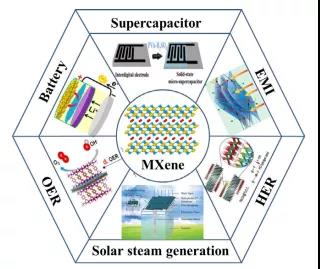CAEJ review: MXene-based nanocomposites for energy storage
QQ Academic Group: 1092348845
Detailed
【Research Background】
New nanomaterials and advanced nanotechnology have promoted the rapid development of sustainable energy conversion and storage technologies. A rising class of two-dimensional transition metal carbonitrides, known as MXenes, has attracted researchers in recent years. Increasingly concerned and conducted in-depth research. Thanks to its unique inherent properties, it is considered to be a very promising alternative material for environmentally friendly energy. A large number of studies have shown that MXenes has great application prospects in the field of energy storage and catalysis. In addition to its excellent performance, MXenes also has some inherent deficiencies, such as low capacity and unstable performance, which greatly hindered its practical application. Recently, Professor Jingquan Liu of Qingdao University published a review article titled MXene-Based Nanocomposites for Energy Conversion and Storage Applications in the internationally renowned academic journal Chemistry-A European Journal, which systematically summarized the latest research progress of MXenes and its composite materials, Including small molecules, polymers, carbon or transition metals and their applications in the field of energy storage, such as in different batteries, supercapacitors, hydrogen evolution/oxygen generation reactions, electromagnetic adsorption/shielding and solar steam power generation. And prospects for future research directions and opportunities.
【Graphic introduction】
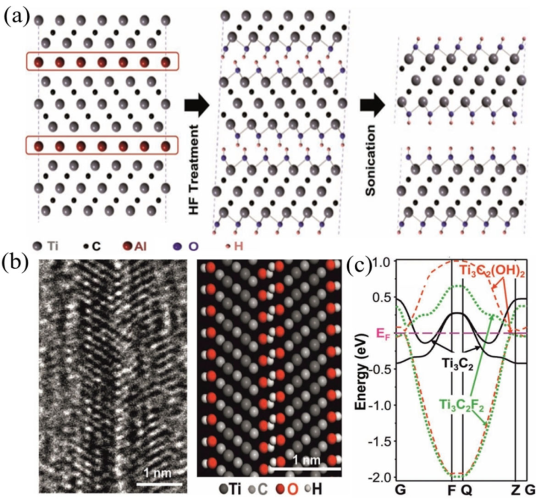
Figure 1. Schematic diagram of the HF peeling process of Ti3AlC2 and the corresponding theoretical calculation.
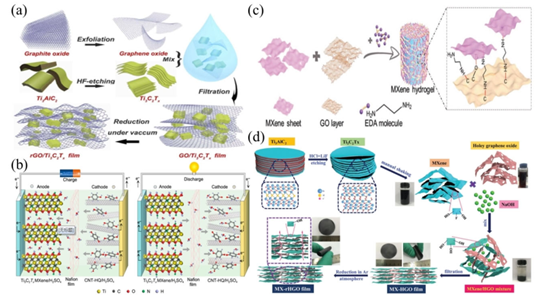
Figure 2. Synthesis process of rGO/Ti3C2Tx film; MXene/CNT hydrogel; MXene hydrogel and modified MXene/porous graphene film;
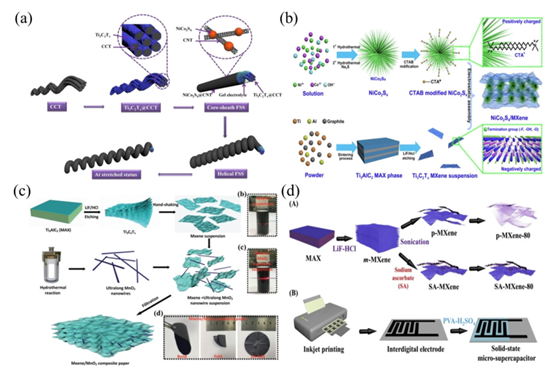
Figure 3. Ti3C2Tx @ rich in N/O carbon cloth; NiCo2S4/MXene composite; Ti3C2Tx/MnO2 mixed dispersion and composite paper; MXene-based solid-state microcapacitor prepared by inkjet printing.
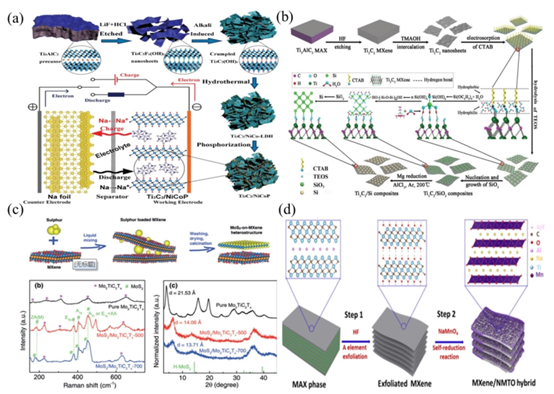
Figure 4. PDT/Ti3C2Tx membrane electrode; laser cutting MXene/bacterial cellulose composite paper for all-solid-state stretchable micro-supercapacitors; graphene-coated, Ti2CTx@polyaniline composite.

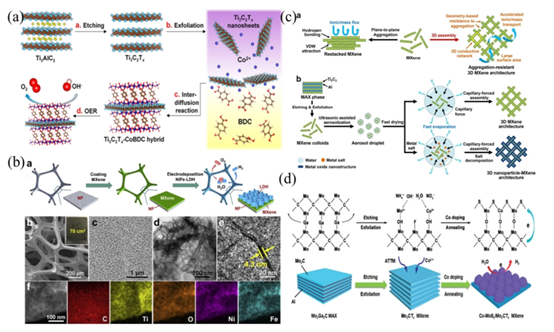
Figure 7. Ti3C2Tx-CoBDC composite for catalysis; mesoporous NiFe-LDH nanosheets grown on macroporous MXene/NF; 3D MXene hydrogel structure; formation of Co-MoS2/Mo2CTx nanocomposites.
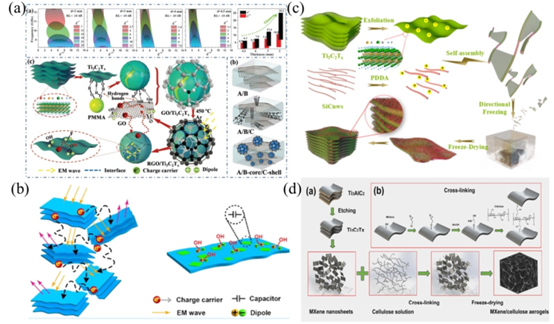
Figure 8. Ti3C2Tx ball and rGO/Ti3C2Tx foam and its electromagnetic adsorption model; f-Ti3C2Tx/SiC nanowire composite foam.
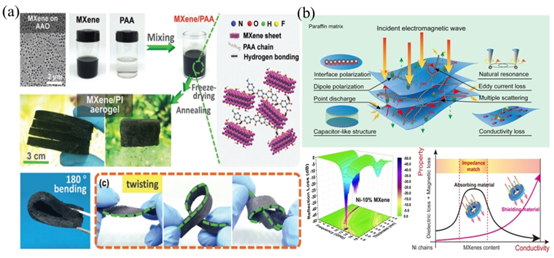
Figure 9. Electromagnetic shielding mechanism of MXene/PI aerogel; MXene/Ni composite.
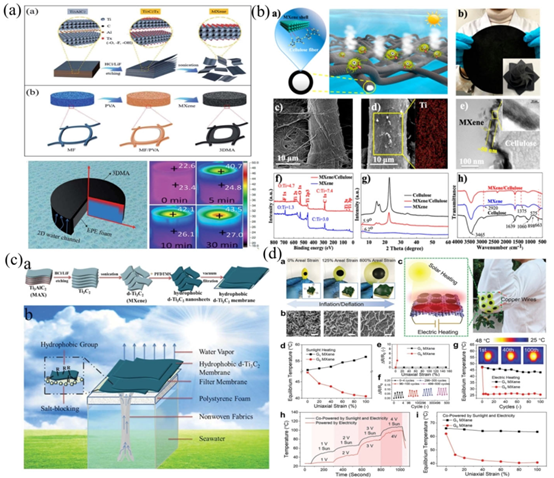
Figure 10. Ultrathin Ti3C2 nanosheets; MXene/cellulose membrane; hydrophobic d-Ti3C2 membrane
【Summary and Outlook】
Although in the past few years, MXenes related research has made tremendous progress, a series of important challenges still need to be solved urgently. i) MXenes has excellent hydrophilicity, thanks to the presence of functional groups on its surface, the use of fluorine-based etchant will lead to the inevitable generation of some surface functional groups. Finding new methods to achieve uniform control of functional groups is very important for the future development of MXene; ii) During the synthesis process, the restacking of MXene nanosheets will limit the entry and efficient use of electrolyte ions, and interlayer engineering can be effective Avoid or reduce heavy stacking obstacles; iii) Obviously, the specific surface area and reaction sites can be greatly improved by reducing the thickness; iv) Morphology modification is also very important to enhance the active sites, pore volume and specific surface area, and then Can further improve performance.
Literature link:
https://doi.org/10.1002/chem.202000191
Source: MXene Frontier
This information originates from the Internet for academic exchange only. If there is any infringement, please contact us to delete it immediately
New nanomaterials and advanced nanotechnology have promoted the rapid development of sustainable energy conversion and storage technologies. A rising class of two-dimensional transition metal carbonitrides, known as MXenes, has attracted researchers in recent years. Increasingly concerned and conducted in-depth research. Thanks to its unique inherent properties, it is considered to be a very promising alternative material for environmentally friendly energy. A large number of studies have shown that MXenes has great application prospects in the field of energy storage and catalysis. In addition to its excellent performance, MXenes also has some inherent deficiencies, such as low capacity and unstable performance, which greatly hindered its practical application. Recently, Professor Jingquan Liu of Qingdao University published a review article titled MXene-Based Nanocomposites for Energy Conversion and Storage Applications in the internationally renowned academic journal Chemistry-A European Journal, which systematically summarized the latest research progress of MXenes and its composite materials, Including small molecules, polymers, carbon or transition metals and their applications in the field of energy storage, such as in different batteries, supercapacitors, hydrogen evolution/oxygen generation reactions, electromagnetic adsorption/shielding and solar steam power generation. And prospects for future research directions and opportunities.
【Graphic introduction】

Figure 1. Schematic diagram of the HF peeling process of Ti3AlC2 and the corresponding theoretical calculation.

Figure 2. Synthesis process of rGO/Ti3C2Tx film; MXene/CNT hydrogel; MXene hydrogel and modified MXene/porous graphene film;

Figure 3. Ti3C2Tx @ rich in N/O carbon cloth; NiCo2S4/MXene composite; Ti3C2Tx/MnO2 mixed dispersion and composite paper; MXene-based solid-state microcapacitor prepared by inkjet printing.

Figure 4. PDT/Ti3C2Tx membrane electrode; laser cutting MXene/bacterial cellulose composite paper for all-solid-state stretchable micro-supercapacitors; graphene-coated, Ti2CTx@polyaniline composite.

Figure 5. Ti3C2@NiCoP composite and working mechanism; Ti3C2/Si composite; Mo2S/MXene composite.
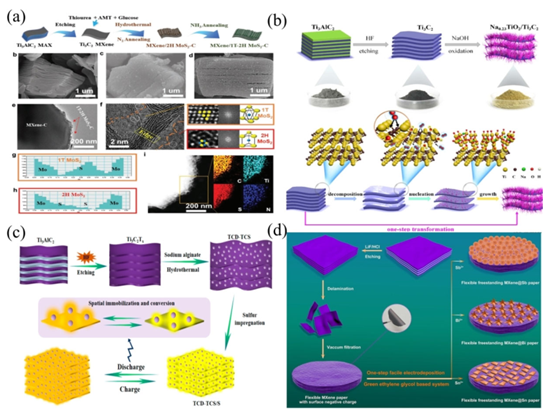

Figure 7. Ti3C2Tx-CoBDC composite for catalysis; mesoporous NiFe-LDH nanosheets grown on macroporous MXene/NF; 3D MXene hydrogel structure; formation of Co-MoS2/Mo2CTx nanocomposites.

Figure 8. Ti3C2Tx ball and rGO/Ti3C2Tx foam and its electromagnetic adsorption model; f-Ti3C2Tx/SiC nanowire composite foam.

Figure 9. Electromagnetic shielding mechanism of MXene/PI aerogel; MXene/Ni composite.

Figure 10. Ultrathin Ti3C2 nanosheets; MXene/cellulose membrane; hydrophobic d-Ti3C2 membrane
【Summary and Outlook】
Although in the past few years, MXenes related research has made tremendous progress, a series of important challenges still need to be solved urgently. i) MXenes has excellent hydrophilicity, thanks to the presence of functional groups on its surface, the use of fluorine-based etchant will lead to the inevitable generation of some surface functional groups. Finding new methods to achieve uniform control of functional groups is very important for the future development of MXene; ii) During the synthesis process, the restacking of MXene nanosheets will limit the entry and efficient use of electrolyte ions, and interlayer engineering can be effective Avoid or reduce heavy stacking obstacles; iii) Obviously, the specific surface area and reaction sites can be greatly improved by reducing the thickness; iv) Morphology modification is also very important to enhance the active sites, pore volume and specific surface area, and then Can further improve performance.
Literature link:
https://doi.org/10.1002/chem.202000191
Source: MXene Frontier
This information originates from the Internet for academic exchange only. If there is any infringement, please contact us to delete it immediately
- Previous: JAC: iron molybdate/MX
- Next: MXene breakthrough: Na


 mxene academic
mxene academic
